
This lesson shows how to write a fraction as a decimal number.
- Subject:
- Mathematics
- Material Type:
- Lecture
- Provider:
- Khan Academy
- Provider Set:
- Khan Academy
- Author:
- Salman Khan
- Date Added:
- 07/18/2011

This lesson shows how to write a fraction as a decimal number.
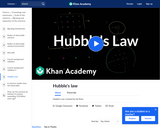
This 11-minute video lesson looks at Hubble's Law. [Cosmology and Astronomy playlist: Lesson 26 of 85]
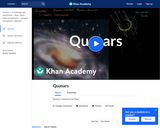
This 9-minute video lesson discusses quasars. [Cosmology and Astronomy playlist: Lesson 35 of 85]
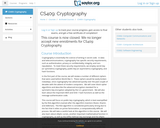
This course introduces cryptography by addressing topics such as ciphers that were used before World War II, block cipher algorithms, the advanced encryption standard for a symmetric-key encryption adopted by the U.S. government, MD5 and SHA-1 hash functions, and the message authentication code. The course will focus on public key cryptography (as exemplified by the RSA algorithm), elliptic curves, the Diffie-Hellman key exchange, and the elliptic curve discrete logarithm problem. The course concludes with key exchange methods, study signature schemes, and discussion of public key infrastructure. Note: It is strongly recommended that you complete an abstract algebra course (such as the Saylor FoundationĺÎĺ_ĺĚĺ_s MA231) before taking this course. Upon successful completion of this course, students will be able to: explain how symmetric and asymmetric key ciphers work; list and define cryptographyĺÎĺ_ĺĚĺ_s goals; list and define the most common classical ciphers; explain the workings of mechanical ciphers Enigma and Lorenz; describe the principles of substitution-permutation networks; describe the algorithms for data encryption and the advanced encryption standard; describe and use the MD5 and SHA-1 hash functions; explain the idea behind public key cryptography; use the RSA cryptography system by applying it to practical problems; test whether the large integer is prime with the mathematical tools presented in this course; define the elliptic curve and use it in cryptography; explain the Diffie-Hellman key exchange; describe the most common signature and autokey identity schemes; describe the conceptual workings of public key infrastructure. This free course may be completed online at any time. (Computer Science 409)
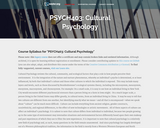
Cultural Psychology reviews the cultural, community, and ecological factors that play a role in how people perceive their environment. The goal of this course is to investigate the ways in which culture can affect aspects of that individual's psychology. Upon successful completion of this course, the student will be able to: identify current trends in contemporary cultural psychology and compare and contrast these concepts with historical and empirical psychological theory; compare and contrast variations in cognitive processes and expectations amongst cultures; describe the difference between measuring and quantifying intelligence within different cultural groups, including culturally normed assessment tools; explain the study of intercultural relations and communication; demonstrate an awareness of theories of cultural differences in affective expression, including both culture-specific and universal concepts; list factors of motivation and cultural implications; identify the stages of human development, including racial and ethnicity-specific developmental theories with a focus on comparing and contrasting individualistic and collectivistic themes; list the criteria for various psychological disorders, including cultural adaptations and culture-bound syndromes. This free course may be completed online at any time. (Psychology 403)
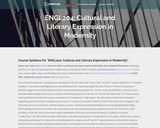
This course seeks to develop a nuanced understanding of the scope of cultural and literary expression in the late 19th and the first half of the 20th centuries. It attends to broad socio-historical happenings, from the birth of modernism in the late 19th century to the post-modern moment. In addition to literary modernism, the course will also take a brief look at the cultural production of modernism in art, music, architecture, cinema, philosophy, and drama. Upon completion of this course, students will be able to: Define the terms modernism and modernity and explain the similarities and differences between these terms using specific works to illustrate comparison and contrast; List and explain the importance of a variety of social, cultural, and historical developments leading up to and occurring during the modern period; Cite and analyze the meaning of primary works of literature, poetry, art, music, architecture, cinema, philosophy and drama to illustrate the principle characteristics of modernism; Compare and contrast the literatures of both France and England from the start of the modern era (i.e., the turn of the twentieth century); Explain the impact of the Great War upon the development and expression of a variety of literary and artistic forms and especially on poetry in a number of genres; Describe the aftermath of World War I and its variety of effects upon literature and art and especially upon the poetry of T.S. Eliot and the novels of Virginia Woolf and Ernest Hemingway; Define High Modernism and give examples of the tenets, ideals, and even the contradictions and self-contradictions of this movement in history and literature (and especially in both its Irish and British contexts); Define the terms postmodernism and deconstruction as well as the phrase Magical Realism and identify the most important characteristics of the movements, fields, theories, and texts associated with these terms; Explain the premises of postcolonial literature and literary theory and identify, describe, compare, and contrast postcolonial texts from range of national origins. (English Literature 204)

The period between the Renaissance and the Modern Era are referred to as the long 18th and 19th centuries, meaning that they span from around 1680-1830 and 1775-1910 - a time in which so many literary movements and cultural changes took place. In this course, the student will examine these formative cultural and literary developments such as the Enlightenment and Restoration Literature; the Rise of the Novel; Romanticism; and the Victorian Period. The student will identify and contextualize the principal characteristics of each of these movements/developments by reading representative texts. Upon completion of this course, students will be able to: identify the major literary trends of the 18th and 19th century, from Restoration comedy and satires through Victorian poetry and prose; outline the major developments in philosophical thought during the Enlightenment and identify these strains of thought in works like Voltarie's Candide; identify the factors that led to the rise of the novel as a literary form; identify the specific traits that characterize early sentimental, Gothic, and picaresque novel; describe the political factors that led to the popularity of Romanticism; describe the shift in thought that led to the split between Romanticism and Enlightenment; identify the themes, conventions, and tropes of Romantic poetry; define and explain the significance of the term/concept of ĺÎĺĺĺŤthe Romantic imagination; define the political, social, and economic factors that led to the surge in popular Victorian fiction; explain the significance of poetic experimentation in the 19th century works of writers like Tennyson, Hopkins, and Browning. (English Literature 203)
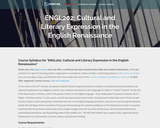
At the outset of the 16th century, Europeans tended to dismiss English literature as inferior to continental literary traditions; the educated Englishman was obliged to travel to the continent and speak in other languages in order to culture himself. By the end of the Renaissance, however, some of the greatest works in the English language from Shakespeare's dramas to Thomas More's Utopia had been written. In this course, the student will read and examine these works, situating them within their socio-historical and literary contexts, while attempting to determine how the art of English language and letters came into its own during this dynamic period. (English Literature 202)

In this course, the student will consider Dante's literature for its stylistic and thematic contributions to the body of Medieval and Italian literature, as well as for its inventive appraisal of Christianity. First, the student will examine the context of Dante's life and works, followed by taking a look at some of Dante's shorter works. Then, the student will devote the majority of the course to the study of Dante's masterpiece,The Divine Comedy. Upon completion of this course, students will be able to: summarize Dante's philosophy on the use of language in literature; identify Dante's attitude towards the relationship between Church and State based on readings from his essays; complete an autobiographical reading of Dante's work, with attention to the influence that specific romantic, political, and religious aspects of his life had on his texts; define important terms related to the study of Dante's work specifically, the poetic devices on which he relied most frequently; identify the structural aspects of The Divine Comedy, and in particular discuss the importance of the overarching circular structure of the text; point to the major biblical, historical, and literary allusions in The Divine Comedy and discuss the significance of these references; perform a cogent reading of the important symbols in Dante's texts (i.e. the presence of light, fire, and roses); critically discuss the key themes in Dante's writings, such as the narrator as pilgrim, divine judgment, and the physical reality of hell. (English Literature 409)
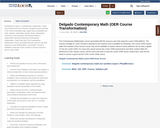
Introduction to topics in contemporary mathematics. Topics may include the theory of finance, perspective and symmetry in art, formal Aristotelian logic, graph theory, probability and odds, statistics, elementary number theory, optimization, numeracy in the real world, and historical topics in mathematics that have influenced contemporary mathematics. (Topics will vary)
The Contemporary Mathematics course associated with this resource was built using the Lumen OHM platform, and GUEST access is available to view the course content in Canvas Commons and in Lumen OHM.

This course deals with the design of drinking water treatment plants. We discuss theory and design exercises.
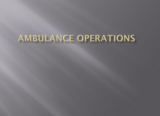
EMS123 Ambulance Operations PowerPoint Presentation
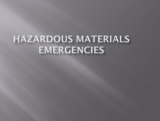
EMS123 Hazardous Materials Emergencies PowerPoint Presentation
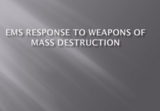
EMS123 Response to Weapons of Mass Destruction PowerPoint Presentation
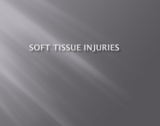
EMS123 Soft Tissue PowerPoint Presentation

In this lecture, Professor Paul Fry examines trends in African-American criticism through the lens of Henry Louis Gates, Jr. and Toni Morrison. A brief history of African-American literature and criticism is undertaken, and the relationship of both to feminist theory is explicated. The problems in cultural and identity studies of essentialism, “the identity queue,” expropriation, and biology are surveyed, with particular attention paid to the work of Michael Cooke and Morrison’s reading of Huckleberry Finn. At the lecture’s conclusion, the tense relationship between African-American studies and New Critical assumptions are explored with reference to Robert Penn Warren’s poem, “Pondy Woods.”
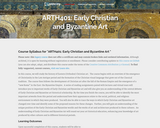
In this course, the student will study the history of Eastern (Orthodox) Christian art. The course begins with the emergence of Christianity and the formation of the Christian visual language that grew out of the Classical tradition. The course then follows the development of Christian art after the fall of the Roman Empire and the emergence of the Byzantine Empire. Upon successful completion of this course, students will be able to: identify works of art from Early Christian and Byzantine culture, recalling such information as date of creation, artist (if known), patron (if known), medium, and culture (i.e. Early Christian, Early Byzantine, Middle Byzantine, Late Byzantine); recognize the features (stylistic and iconographic) typical of the arts of the early Christian and Byzantine world; explain and discuss the general arc of the history of Early Christian and Byzantine culture; describe the significance and function of works of art produced in Early Christian and Byzantine culture; discuss the sources of influence (from previous historical periods as well as from neighboring geographical regions) that affected Early Christian and Byzantine art; compare and contrast works of early Christian and Byzantine art to those of other cultures; explain the relationship between Christianity (and Early Christian art) and Byzantine culture, and discuss the symbiotic nature of this relationship; describe the methods and materials used to create works of Early Christian and Byzantine art; explain the ways in which Early Christian and Byzantine art reveals the social, religious, and political mores of the culture. (Art History 401)
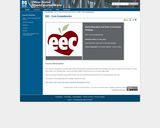
This course is designed to provide early childhood education professionals with the knowledge and skills to assess their own level in terms of the eight core competencies, across the infant-toddler, preschool and out-of-school age range. This survey course consists of eight learning modules. Each module is based on one of the eight core competencies: 1) understanding growth and development of children and youth, 2) guiding and interacting with children and youth, 3) partnering with families and communities, 4) health, safety and nutrition, 5) learning environments and curriculum, 6) observation, assessment and documentation, 7) program planning and development, and 8) professionalism and leadership. Includes Powerpoint audio lectures, syllabus, and self-assessments. This course can be used for self-documentation of professional development hours.

This course will introduce the student to the history of the world's major civilizations from medieval times to the early modern era. The student will learn about the pivotal political, economic, and social changes that took place in Asia, Africa, the Americas, and Europe during this period. By the end of the course, the student will understand how many different civilizations evolved from isolated societies into expansive, interconnected empires capable of exerting global influence. Upon completion of this course, students will be able to: Think critically and analytically about world history in the medieval and early modern eras; Identify and describe the emergence, decline, and main features of the Byzantine Empire; Identify the origins and characteristics of the European medieval period and describe the rapidly changing forces at work in society, the economy, and religion during this time; Identify the origins of the Aztec and Inca civilizations and assess how these empires affected socio-economic development in the Americas; Identify the origins of the Tang and Song dynasties in China and assess the impact of these empires on Chinese government, society, religion, and economy during what scholars refer to as the 'golden age'; Identify the origins of the Mongol Empire, which dominated much of Asia in the twelfth and thirteenth centuries. Students will analyze the nature of this empire created by nomads; Identify the reasons for a changing balance in the world economy in the 1400s and analyze why Europe superseded Asia as the most dominant civilization on the globe; Assess how and why the European Age of Discovery had such a large impact on the New World, Africa, the Middle East, and Asia; Identify the origins and characteristics of the Renaissance and describe its impact on European civilization as a whole; Identify the origins of the Reformation and Counter-Reformation in Europe and assess how this movement altered the social, political, and religious fabric of Europe; Identify the origins of colonial Brazil and New Spain. Students will also be able to assess the impact of Spanish and Portuguese colonization on the New World, Africa, and Europe; Identify the origins of the Ottoman, Safavid, and Mughal empires and assess the unique characteristics of these dynasties and their impact upon Asia and the world; Identify the origins of the Atlantic slave trade, assessing how this forced migration of peoples affected Africa, Africans, Europe, and the New World; Analyze and describe the Asian trading world, the Ming dynasty in China, the ĺÎĺĺĺŤwarring states,' and early modern eras in Japan; Analyze and interpret primary source documents from the medieval period to the early modern era using historical research methods. (History 221)

This 6 minute video will explain the benefits and costs associated with buying a home versus renting a home. This video will aid in the mastery of standard EPF. 11 (b)